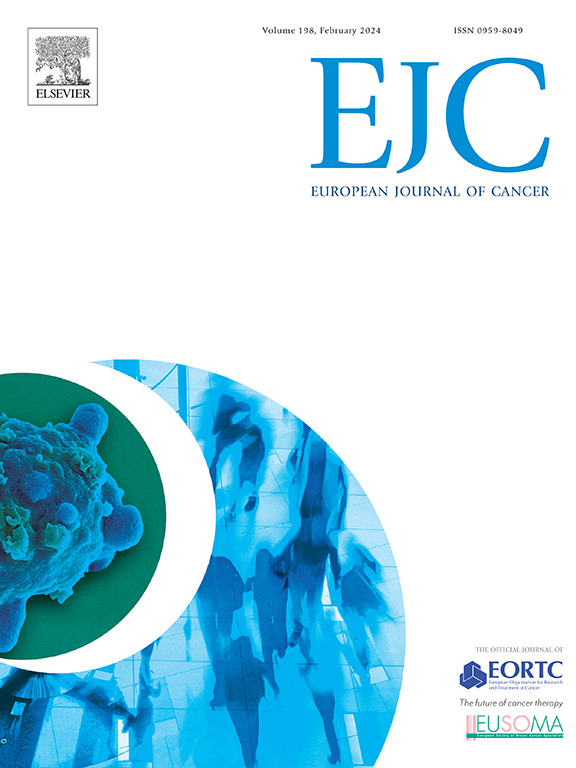默克尔细胞癌的临床病程:1049例DeCOG多中心研究
IF 7.6
1区 医学
Q1 ONCOLOGY
引用次数: 0
摘要
背景梅克尔细胞癌(MCC)是一种侵袭性很强的皮肤癌,具有神经内分泌分化的特点,经常复发。大型流行病学数据库(如 SEER、IARC)在分析肿瘤、患者特征、局部区域干预和复发模式之间的关联方面缺乏精细性。患者和方法在前免疫疗法时代(1998-2017 年),DeCOG MCC 登记纳入了 1049 名经组织病理学证实的 MCC 患者。对患者/肿瘤特征、治疗细节和结果进行了分析。主要终点是无进展概率(PFP)和疾病特异性生存率(DSS)。结果确诊时的平均年龄为74岁;50.4%为男性。原发性肿瘤最常发生在头颈部(32.2%)和上肢(29.1%)。三分之一的患者病情≥IIIA期。中位随访时间为10年,36个月和60个月的PFP率分别为69.0%和63.9%;DSS率分别为86.9%和82.6%。1-2厘米的手术切缘能最好地改善PFP和DSS;2厘米的切缘并不能进一步改善临床预后。同样,对于 IIIA 期患者,完全淋巴结清扫(CLND)既不能改善 PFP,也不能改善 DSS。早期放疗(诊断后 8 周)可显著改善 PFP(HR 1.36)和 DSS(HR 1.79)。将放疗范围扩大到淋巴结床没有额外的益处。与单个转移灶患者相比,首次复发时有多个转移灶的患者的DSS较差(HR 2.0),不论是局部转移还是远处转移。更大的手术切缘、IIIA期的CLND或扩大的治疗放射野并不能改善生存预后。本文章由计算机程序翻译,如有差异,请以英文原文为准。
Clinical course of Merkel cell carcinoma: A DeCOG multicenter study of 1049 patients
Background
Merkel cell carcinoma (MCC) is a highly aggressive skin cancer with neuroendocrine differentiation characterized by frequent recurrences. Large epidemiological databases (e.g., SEER, IARC) lack granularity in analyzing associations between tumor, patient characteristics, locoregional interventions and recurrence patterns.
Patients and methods
Within the pre-immunotherapy era (1998–2017) the DeCOG MCC registry included 1049 patients with histopathologically confirmed MCC. Patient/tumor characteristics, treatment details, and outcomes were analyzed. Primary endpoints were progression-free probability (PFP) and disease-specific survival (DSS).
Results
Median age at diagnosis was 74 years; 50.4 % were males. Primary tumors most frequently occurred on the head/neck (32.2 %) and upper extremities (29.1 %). One-third of patients presented with stage ≥IIIA disease. At a median follow-up of 10 years, 36- and 60-months PFP rates were 69.0 % and 63.9 %, respectively; DSS rates were 86.9 % and 82.6 %. Surgical margins of 1–2 cm provided the best PFP and DSS improvement; margins > 2 cm did not further improve clinical outcome. Similarly, for stage IIIA patients a complete lymph node dissection (CLND) did neither improve PFP nor DSS. Early radiotherapy (<8 weeks post-diagnosis) significantly improved PFP (HR 1.36) and DSS (HR 1.79). Expansion of radiotherapy to lymph node bed showed no additional benefit. Patients with multiple metastases at first recurrence had poorer DSS (HR 2.0) compared to those with single metastases, irrespective of locoregional or distant spread.
Conclusions
MCC outcomes are optimized with surgical margins of 1–2 cm and timely adjuvant radiotherapy. Larger margins, CLND in stage IIIA, or extended treatment radiation fields did not improve survival outcomes.
求助全文
通过发布文献求助,成功后即可免费获取论文全文。
去求助
来源期刊

European Journal of Cancer
医学-肿瘤学
CiteScore
11.50
自引率
4.80%
发文量
953
审稿时长
23 days
期刊介绍:
The European Journal of Cancer (EJC) serves as a comprehensive platform integrating preclinical, digital, translational, and clinical research across the spectrum of cancer. From epidemiology, carcinogenesis, and biology to groundbreaking innovations in cancer treatment and patient care, the journal covers a wide array of topics. We publish original research, reviews, previews, editorial comments, and correspondence, fostering dialogue and advancement in the fight against cancer. Join us in our mission to drive progress and improve outcomes in cancer research and patient care.
 求助内容:
求助内容: 应助结果提醒方式:
应助结果提醒方式:


